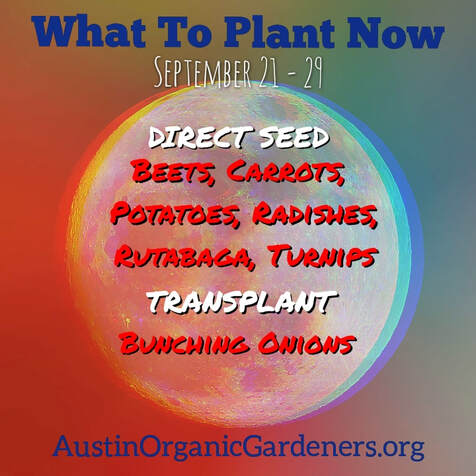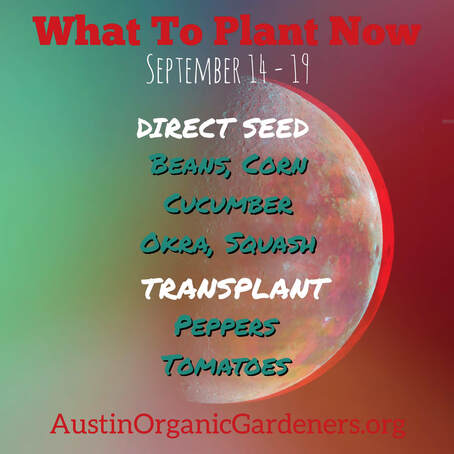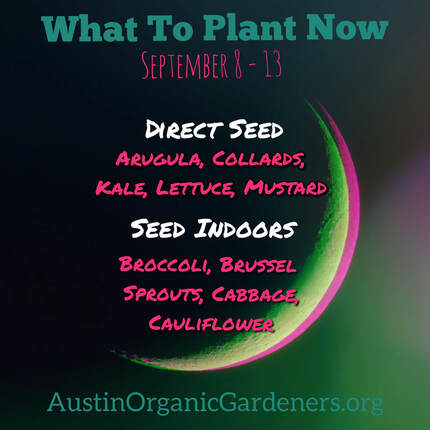 We just passed the Harvest Moon and autumnal equinox for the Northern Hemisphere comes on September 22. We hope that you have all your summer crops harvested and have been preparing your soil for fall crops because there is a lot of root veggies you can direct seeds. We are now going into a waning period of the Moon—from the day after it is full to the day before it is new again. As the moonlight decreases night by night, plants are encouraged to grow roots, tubers, and bulbs. It’s always best to try to plant with the coming rains which are in the forecast. DIRECT SEED Beets Carrots Potatoes (Irish) Radishes Rutabaga Turnips TRANSPLANT Bunching Onions WHERE TO BUY The Natural Gardener and Cultivate Holistic Supply will have bunching online transplants in September. MORE IDEAS For more ideas on Ornamentals, Perennials, and Herbs, visit the Central Texas Gardener and The Natural Gardener lists online. Download the Texas A&M Extension Planting Chart and Varieties.  We just passed the first quarter and the moon is now waxing gibbous going into a full moon. Now is also a time to seed-in plants that fruit and seed like beans, corn, cucumbers, okra, and squash. If you already planted these things, remember that it’s a good idea to succession plant and grow twice as much as you will need in case of disease and pest. As always, it’s best to transplant and seed-in with coming rains. DIRECT SEED TRANSPLANTFor more ideas on Ornamentals, Perennials, and Herbs, visit the Central Texas Gardener and The Natural Gardener lists online. Download the Texas A&M Extension Planting Chart and Varieties Chart on our website. This past Saturday we trench composted our summer cover crops to add nutrients back to the soil in prep for our fall planting. This is known as the “lazy man’s” method of composting because you’re burying your "green manure" or compost directly into the soil, right in the garden. This hassle-free method is an easy way to enrich your soil without the odors, turning and watering, or having a large compost bucket or pile in your backyard. Learn more about cover crops here.
WHERE: Between rows, at center of bed, in our case we did it at the top of the bed because it is on a slight hill and nutrients will eventually reach all plants. Be sure to rotate and move your trench every growing season so new parts of your garden will be revitalized. If trenching between rows, be sure to plant rows far enough apart so that you don’t harm roots while digging. WHEN: Anytime in the growing season, but best to do it in between seasons so you can use cover crops, plants you are cutting back HOW: Dig a hole roughly 12 inches deep and wide enough to bury whatever scraps you have collected, dump in 4-6 inches of compostable material, and cover it back up with dirt. WHAT:
 We just passed the New Moon phase and are now approaching the First Quarter and are in Waxing Crescent. During the waxing of the moon (the period extending from the day the moon is new to the day it reaches its fullest point), the moon pulls moisture upwards. Seeds do well during this time because moisture is available at the surface of the soil. Fall is a great time for planting veggies in Central Texas and now is the time to get things started if you are planting leafy greens from seed both outdoors and indoors. DIRECT SEED OUTDOORS
In Central Texas you can start your brassica seeds indoors in late summer and set them in the garden in autumn for winter harvest. Many of these crops need 120 days to harvest and this gives them a tolerable soil temperature indoors to get a head start. All of these crops can also thrive and do well in frost.
Continue to use seaweed as things are hot and do weekly foliar sprays with liquid seaweed to provide plants with hormones and nutrients needed for heat stress and to prevent disease and pests. Also don’t forget to collect deadhead flowering plants. It’s also a good time to start composting because leaves are starting to fall. Fall is a good time to transplant, trade, or give away your divisions of daylilies, bearded irises, violets, wood ferns, cannas, and other herbaceous perennials. Perennials should be divided every few years to keep growth uniform and vigorous. If your larger plants are beginning to show bald spots in the center, or you notice your bulbs not blooming as much as they used to, that’s a good sign it’s time to divide your plants. For more ideas on Ornamentals, Perennials, and Herbs, visit the Central Texas Gardener and The Natural Gardener lists online. Download the Texas A&M Extension Planting Chart and Varieties.
This Saturday at beds at Zilker Botanical Garden we gave our cucumber plants a seaweed treatment to help them de-stress. Austin Organic Gardeners have long used to seaweed for its many benefits in the garden including: 1. FERTILIZER Seaweed is a broad spectrum fertilizer that has 60 trace minerals and ready-to-use nutrients including nitrogen, potassium, phosphate, and magnesium. It also contains hormones to encourage plant growth. Seaweed is high in carbohydrates which are essential building blocks in growing plants, and low in cellulose so it breaks down readily. 2. PEST CONTROL. Slugs especially hate seaweed because of its sharp edges and salt. Birds and other garden pests dislike it for the same reasons. 3. PREVENTS DISEASE Seaweed helps you to grow strong, healthy plants, and healthy plants resist disease. Seaweed shares no diseases with land plants. HOW TO APPLY It can be bought at local garden stores and comes as a powder that is water soluble or as liquid concentrate. Powdered form adds organic matter and also aerates the soil. For the solid, work about 10 lbs. per 100 sq. ft. into the soil. For the liquid, follow label directions for dilution. |
AuthorWrite something about yourself. No need to be fancy, just an overview. Archives
May 2024
Categories |
 RSS Feed
RSS Feed